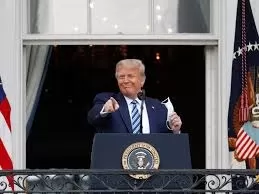Trump's Public Speaking and White House Workload: A New Era of Presidential Communication
Since returning to the White House for his second term, President Donald Trump has significantly increased his public speaking compared to his first presidency. The White House stenographers are finding themselves under considerable pressure, struggling to keep pace with Trump's extended public remarks and frequent communications.

In his first week alone, Trump managed to speak over 81,000 words, far surpassing the word count of his predecessor, President Joe Biden, who used 24,259 words in his first week.
This surge in speech time and word count has led to internal discussions about the need for additional staff to keep up with the workload of transcribing Trump's public remarks. In comparison, during his first week in office back in 2017, Trump only spoke for 3 hours and 41 minutes, totaling 33,571 words. The sharp contrast between his first term and his current presidency highlights how Trump's communication style has evolved and how it has impacted White House operations.
Trump's Inauguration and Early Public Speaking
From the moment President Trump took office, he made it clear that he intended to speak often and extensively. After delivering his inauguration address, Trump quickly followed up with even more remarks, holding rallies and engaging with supporters. His public speeches have not been limited to formal addresses but have included impromptu sessions, such as speaking to reporters during his travels and in the Oval Office while signing executive orders.
Trump's habit of speaking frequently to the media has been a hallmark of his presidency. In his first week in 2025, he gave 7 hours and 44 minutes of public remarks, showing no signs of slowing down. During this time, he was seen addressing large crowds and holding informal sessions with reporters, often from Air Force One. This marks a sharp contrast to the more reserved approach of President Biden, whose public speaking time in his first week was substantially shorter.
Transparency or Accessibility? A Fine Line
Trump's communication strategy has raised questions about transparency. His long-time aide, Margo Martin, claimed that "transparency is back," suggesting that the president’s frequent public statements should be seen as a step toward greater openness. However, critics are quick to point out that there is a significant difference between being accessible and being transparent. Accessibility refers to the act of making oneself available for interaction, while transparency is about providing clear, honest, and comprehensive information to the public.
Trump’s frequent remarks are often seen as part of his broader strategy to control the narrative. While his accessibility through public speaking is undeniable, critics argue that the volume of his statements does not always translate into transparent communication. The challenge lies in the depth and substance of these remarks, with some questioning whether they truly offer clarity or are more focused on maintaining media attention.
Social Media Influence and Transparency
Trump’s extensive use of social media has been another defining feature of his presidency. Having tweeted over 25,000 times during his first term, Trump continued to make headlines for his online activity. Although he shifted from Twitter to his own platform, Truth Social, since taking office in 2025, his tweets and posts still make up a significant part of his communication strategy. In fact, he has already tweeted over 125 times in his new presidency, suggesting that he is as committed as ever to using social media as an official communication tool.
The White House has consistently stated that Trump’s tweets should be considered as official statements, further blurring the line between traditional government communication channels and social media. This continued reliance on social media allows Trump to bypass traditional media outlets and engage directly with the public, but it also raises concerns about accountability and the reliability of information.
The Impact on White House Operations
With the increase in public speaking, social media posts, and impromptu remarks, the workload for the White House staff, particularly the stenographers, has skyrocketed. The need for real-time transcription and documentation of Trump’s remarks is now an ongoing challenge. The constant influx of public speeches, rallies, and press conferences has led to discussions within the White House about hiring more personnel to manage the growing demand.
This shift is reflective of a broader trend in presidential communication, where the line between formal statements and spontaneous remarks is becoming increasingly blurred. The sheer volume of words spoken by Trump in his first few weeks has set a new precedent for the modern presidency, and it is clear that the administration must adjust to accommodate this change.
Looking Ahead: Will Trump’s Speaking Style Continue to Dominate?
As President Trump settles into his second term, it seems likely that his approach to communication will continue to dominate the political landscape. His frequent speeches, rallies, and social media activity indicate that he intends to remain in constant contact with the public, maintaining his status as a highly visible and accessible figure. However, the challenges associated with his communication style—such as the need for increased staffing and the potential risks to transparency—will likely continue to play a significant role in shaping the rest of his presidency.
For the White House, this could mean a rethinking of how public communication is managed in an era where the speed and volume of information have reached unprecedented levels. For Trump, his ability to stay in the public eye will remain a key asset, but it will also require careful management to ensure that it does not overwhelm the White House’s operations.
Conclusion: A New Era of Presidential Communication
Donald Trump’s return to the presidency has brought with it a new era of public speaking and communication. With a significantly higher word count and more frequent interactions with the media, Trump has set a new bar for presidential communication. While his accessibility and use of social media may be seen as a sign of transparency, critics remain skeptical about the true substance of his remarks. As the White House grapples with the challenges of managing this new communication dynamic, one thing is clear: Trump’s presidency will be defined by its constant presence in the public eye. Whether this approach will continue to serve him or create operational hurdles for his administration remains to be seen.
What's Your Reaction?
















